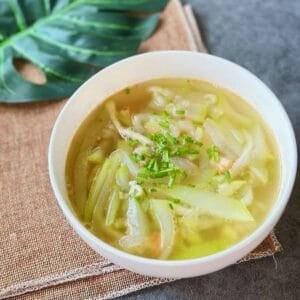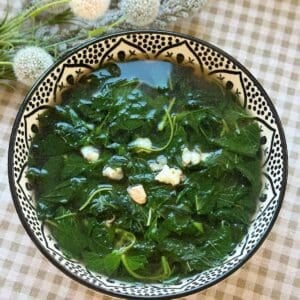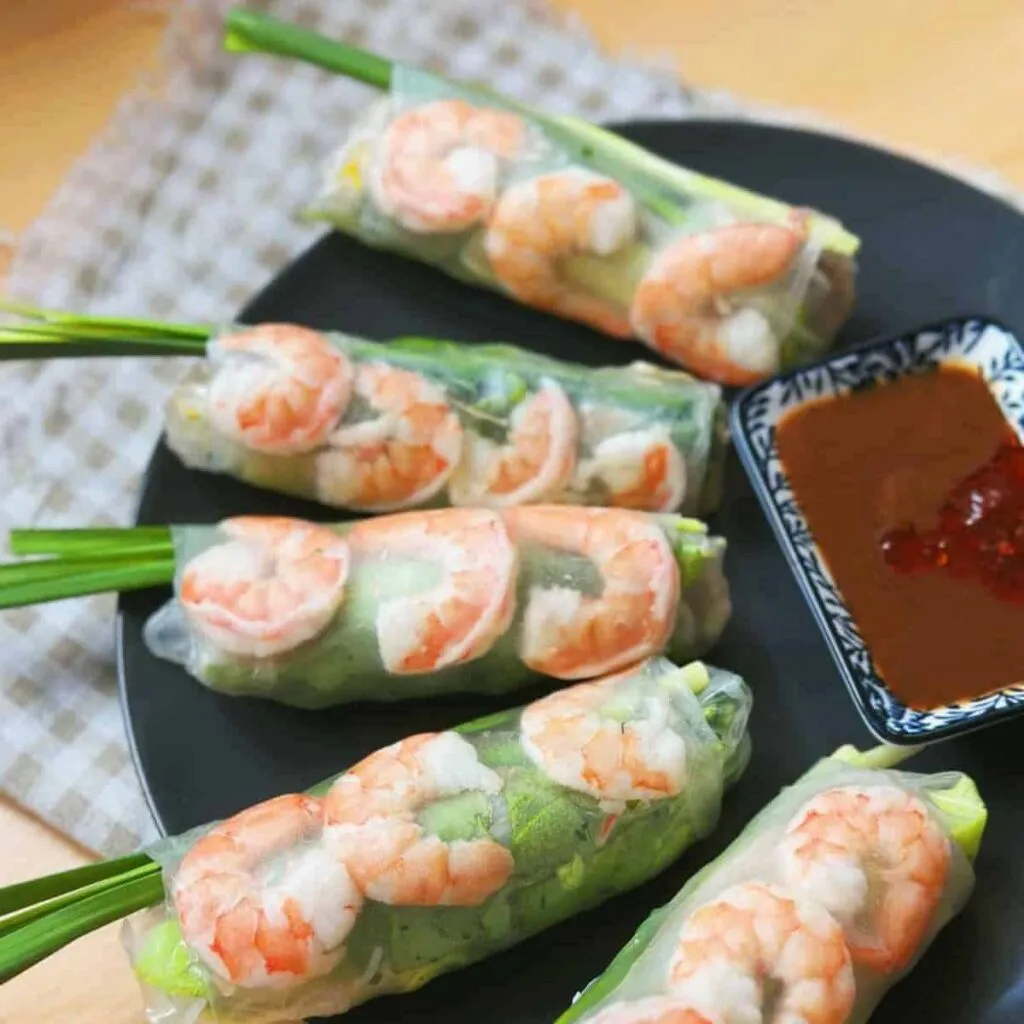Canh Chua is my ultimate Vietnamese summer comfort—light, tangy, and packed with fresh herbs, the kind of soup that cools you down and tastes like home.
Here in Germany, tamarind, herbs, or the right fish can be hard to find, but I’ll show you easy swaps so you can still enjoy this Mekong Delta classic anywhere.

What is Canh Chua?
In Vietnamese, the name simply translates to “sour soup,” but canh chua is so much more than that.
It’s a bright, refreshing blend of sweet, sour, savory, and a touch of spice—the kind of balanced flavors that define Southeast Asian cooking, much like Tom Yum or Sinigang.

Related Recipes | More easy Vietnamese “canh” (light soups)
The Unique Sour Flavors of Canh Chua Across Vietnam’s Three Regions
Canh chua is loved nationwide, but its sourness shifts beautifully from North to South. Each region leans on its own ingredients and traditions, creating distinct yet equally comforting versions of this classic soup.
The version I’m sharing is the beloved Mekong Delta style with tamarind, the one most people outside Vietnam are familiar with.
And now that I live in Germany, I sometimes lean on rhubarb stalks when tamarind is hard to find. It may sound a bit quirky, but it brings that soft, refreshing tartness beautifully.
1. Northern Canh Chua
Northern-style canh chua is all about gentle, elegant flavors—very much in line with Hanoi’s refined cooking style.
The sourness often comes from tamarind, starfruit, or quả sấu (dracontomelon fruits), along with naturally fermented ingredients like giấm bỗng (rice wine vinegar) or mẻ (fermented rice).
2. Central Canh Chua
Central Vietnam is famous for its spicy, bold cuisine, and its canh chua is no exception. With plenty of shrimp, squid, and ocean fish in local cooking, the mix of sour and spicy notes helps balance everything out.
The sourness usually comes from starfruit, pineapple, tomatoes, pickled bamboo shoots or pickled mustard greens.
3. Southern Canh Chua
In the produce-rich South, especially the Mekong Delta, you’ll find the most vibrant, generous versions of canh chua. Southerners use everything from tamarind, starfruit to lá giang (sour-soup creeper leaves) to build that sour base. Freshwater fish like snakehead or catfish are the stars here.
With the South’s love for bold seasoning, their canh chua often carries a gentle sweetness that rounds out the sourness, creating that lush, well-balanced flavor the region is known for.
What is in Southern Canh Chua?

Vegetables & Herbs
One thing about Vietnamese cooking—you’ll often come across herbs and veggies that look a bit intimidating at first (I get it—that’s exactly why I write full posts to introduce Vietnamese vegetables and Vietnamese herbs).
Back in Vietnam, you can simply tell a market vendor what you need—or grab a ready-made pack of ingredients made just for Canh Chua. That’s exactly what I did today: picked one up and unpacked it to show what’s typically used to make this delicious soup.

Veggies:
- Tomato & Pineapple – The sweet-and-sour backbone of the broth. Canned pineapple (and even its juice) works fine if fresh isn’t available—just be gentle with the sugar.
- Tamarind – The heart of Canh Chua. My mom swore by fresh pods, but I usually reach for sticky pulp or concentrate for convenience. Tamarind powder works too. (Pro tip: stick with Southeast Asian brands—Indian tamarind tastes quite different.)

- Bean Sprouts – A must! Added right at the end for crunch and freshness.
- Banana Blossoms – Optional, but a charming addition in my hometown Nha Trang’s version. They also pop up in noodle soups like Bun Moc, Mi Quang, and Bun Bo Hue.
- Okra (Đậu Bắp) – Mild, slightly slippery, and classic in Canh Chua. Not everyone loves the texture, but it’s part of the tradition.
- Elephant Ears / Taro Stems (Bạc Hà / Dọc Mùng) – My favorite—soft, sponge-like, and perfect for soaking up the broth. If you can’t find them in Germany, celery stalks do the trick.
Herbs – The real magic behind Canh Chua’s aroma.
- Rice Paddy Herbs (Ngò Om / Rau Ngổ) – Citrusy, slightly earthy, and essential for that authentic Mekong Delta flavor.
- Culantro (Ngò Gai) – Often paired with rice paddy herbs for depth.
- Lemon Basil (É Trắng) – More common in Central Vietnam and the one I grew up with.
- Green Onions (Hành Lá) – A nice touch, but optional.


Tip for cooking order:
Start with tomato and pineapple to flavor the broth, then add the “hearty” veggies like okra and taro stems, and finally the quick-cook ones like bean sprouts, banana blossoms, and fresh herbs.
Seasonings & Garnishes
- Sugar, Fish Sauce & a pinch of Chicken Powder – balance out the tangy tamarind.
- Thai Chilies – Only if you like heat.
- Fried Garlic or Fried Shallots – In the Mekong Delta, a sprinkle of fried garlic is the final touch that makes Canh Chua absolutely irresistible. You can find it at Asian markets, or easily make it at home.
Protein
- Freshwater Fish in the Mekong Delta – Catfish (cá basa), snakehead (cá lóc), and red tilapia (cá diêu hồng) are the favorites here.
- Seawater Fish – Back in my coastal hometown, mackerel and tuna are more common.
- No Stress Abroad – Outside Vietnam, salmon, halibut, cod, or even shrimp and squid all make fantastic Canh Chua. Fish heads? Grab them! They add a rich, deep umami that fillets alone can’t match.
- Beyond Fish – Canh Chua isn’t limited to seafood. Many families use pork ribs, bone-in chicken, or tofu for a vegetarian version.
Extra Tips for Preparing the Fish
Choose Your Cut – You can use fillets, or ask your fishmonger to slice a whole fish into 1-inch (2 cm) steaks with skin and bones. It adds so much more flavor to the broth.
Rinse and Salt – Always rub and rinse the fish (especially catfish) with coarse salt to get rid of the slimy coating.
Optional Ginger Rub – For an extra touch, a quick rub with minced ginger helps reduce any fishy smell.
Instructions
Step 1: Prep the Ingredients
- Chop herbs and chili, cut okra into small pieces, peel and slice elephant ear stems, wedge the tomato, and chunk the pineapple (drain and save juice if using canned). Mince garlic for frying.
Step 2: Make the Fried Garlic
- Fry minced garlic in oil until light golden, then strain immediately. Set aside for garnish.
👉 Don’t let it get too brown, or it will turn bitter.
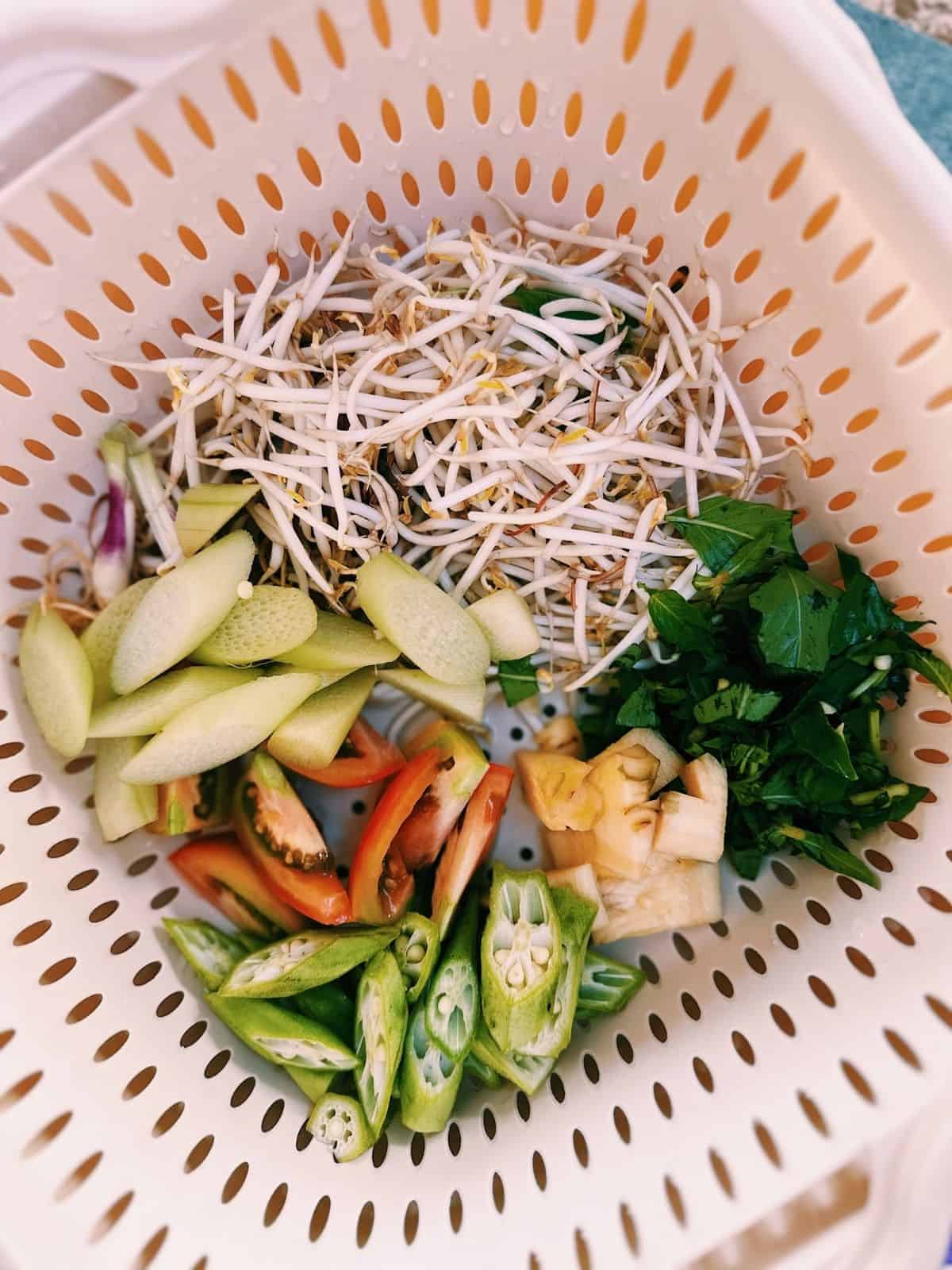
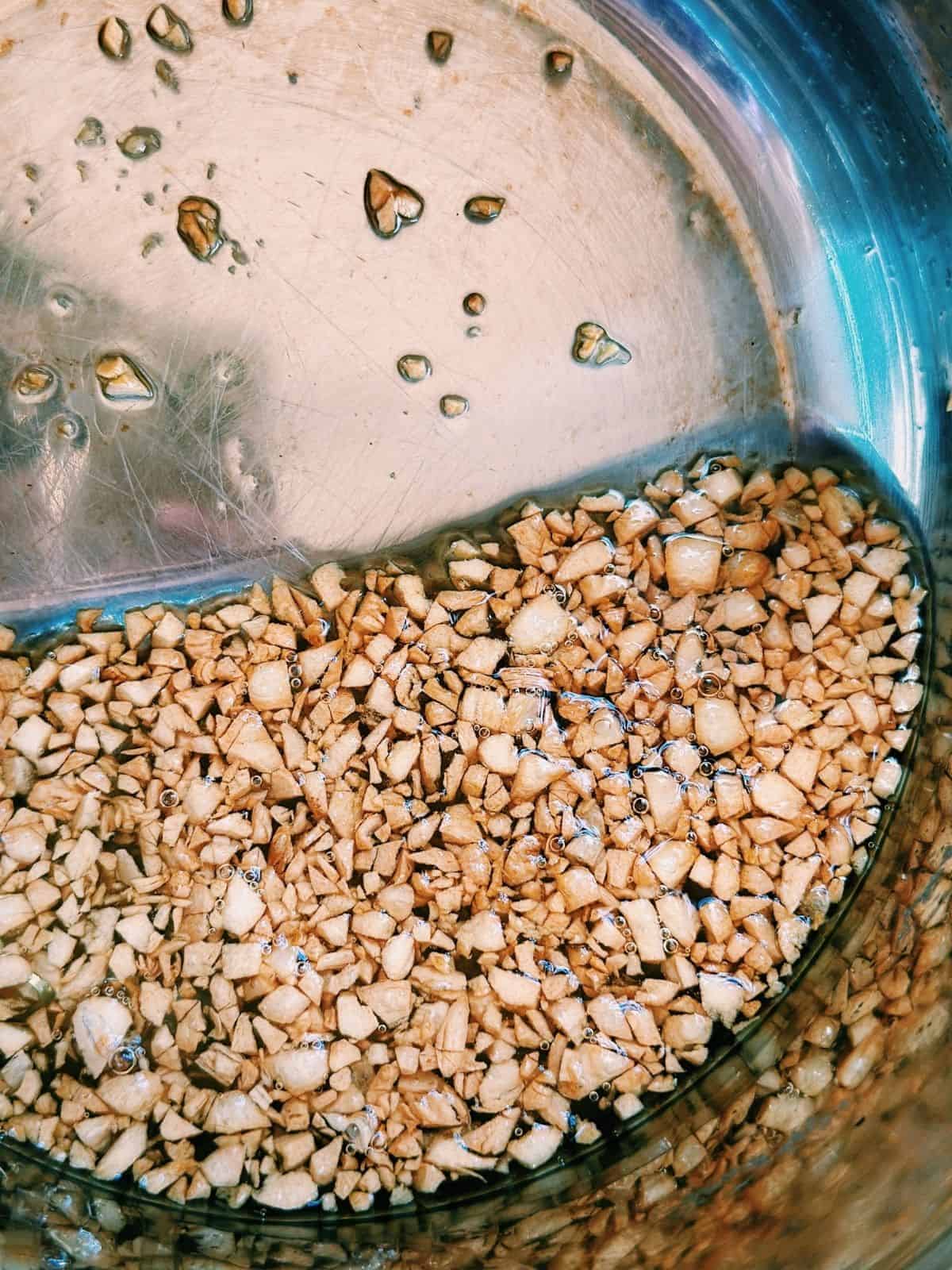
Step 3: Build the Broth
- Bring water to a boil. Add tomato and pineapple to simmer for sweetness. Dissolve tamarind pulp with hot water (or use concentrate) and add 3–4 tablespoons of it to the pot.
- Season with fish sauce, sugar, a pinch of chicken powder, and pineapple juice if available. Gently add the fish and cook until done.
Step 4: Add Veggies & Finish
- Add okra, elephant ear stems, and remaining tomato wedges. Cook briefly, then turn off the heat. Stir in bean sprouts, banana blossoms (optional), and herbs.
- Taste again, adjust seasoning, and garnish with fried garlic, herbs, and chili before serving hot with rice.
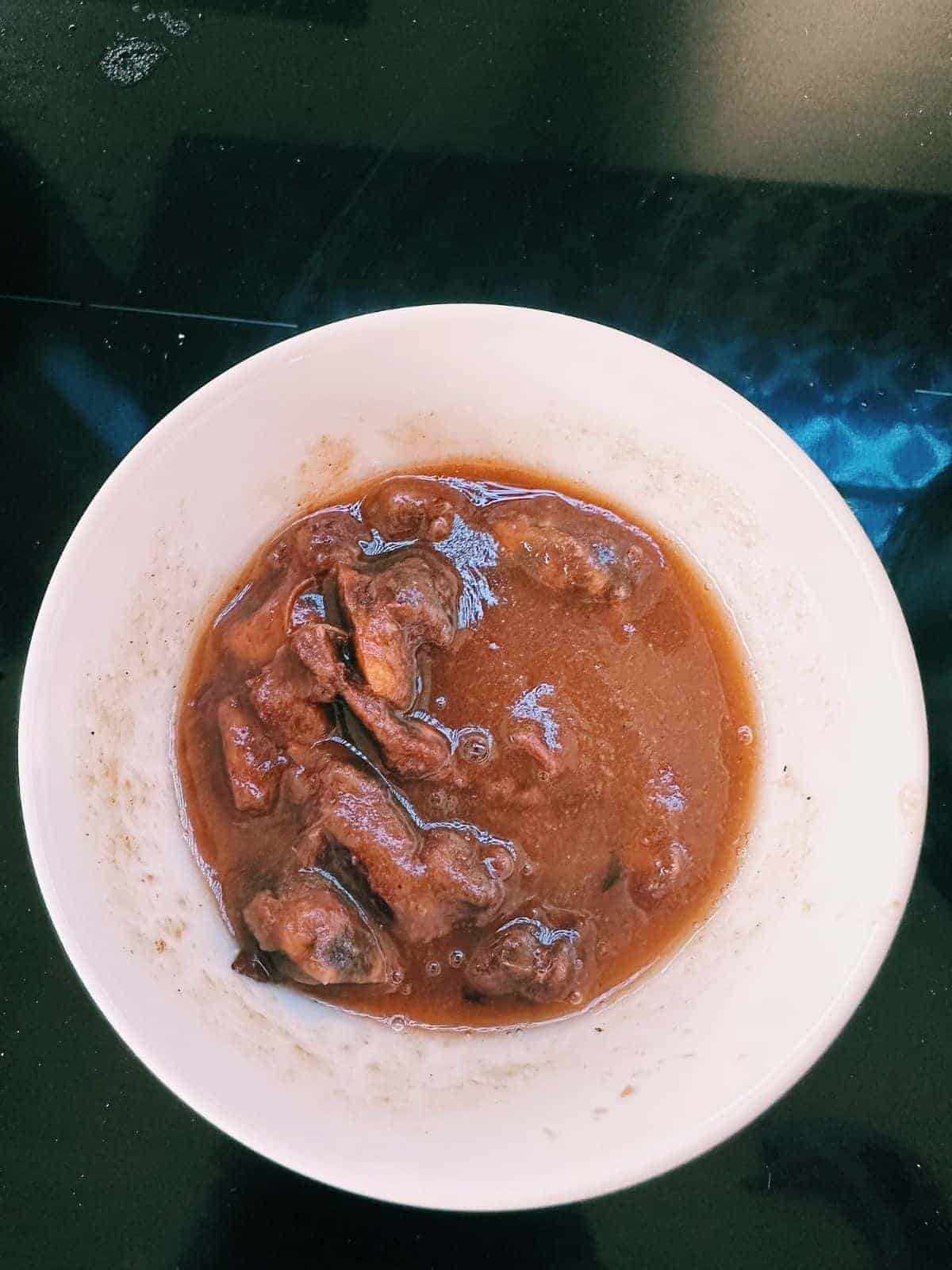
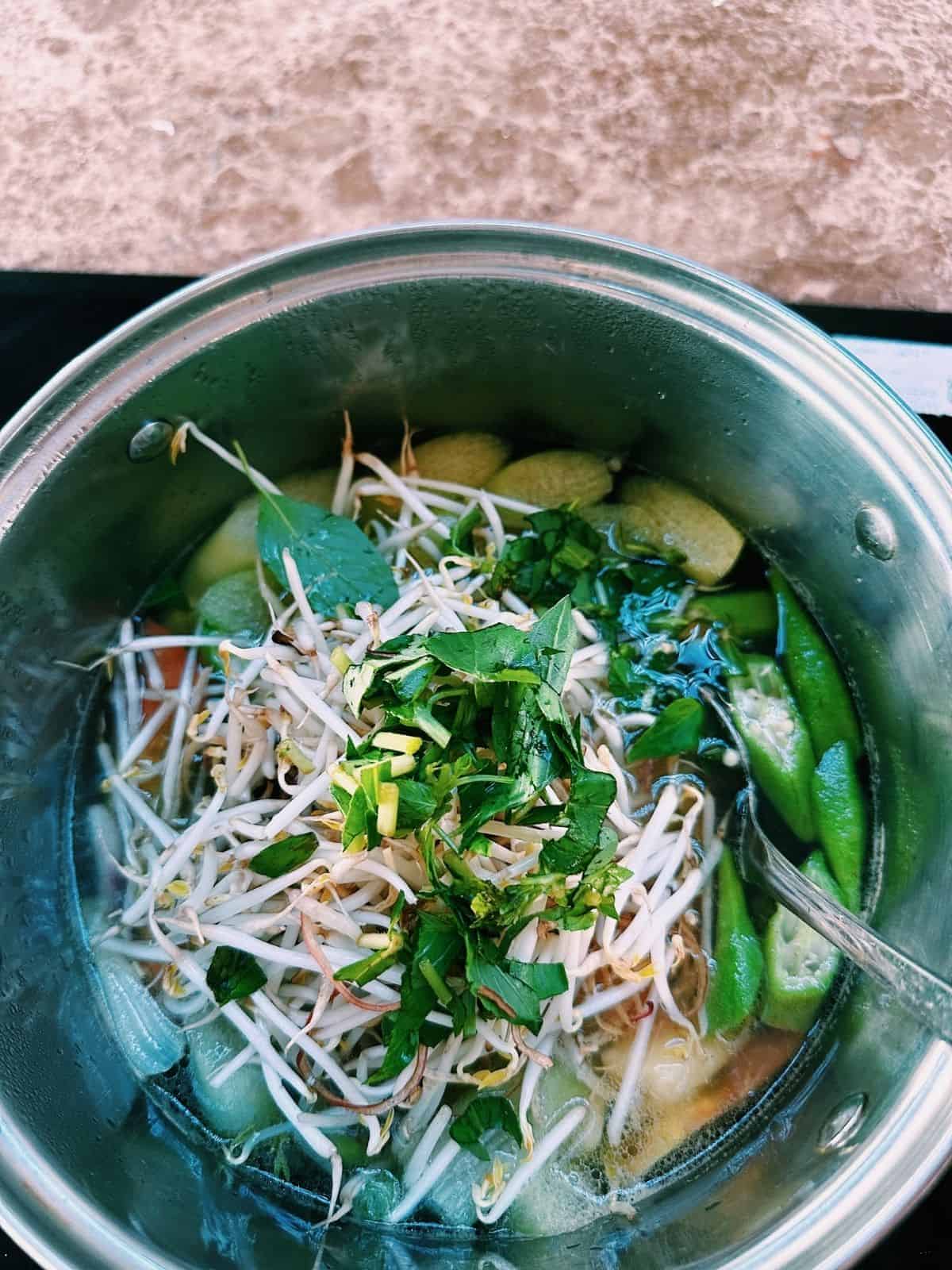
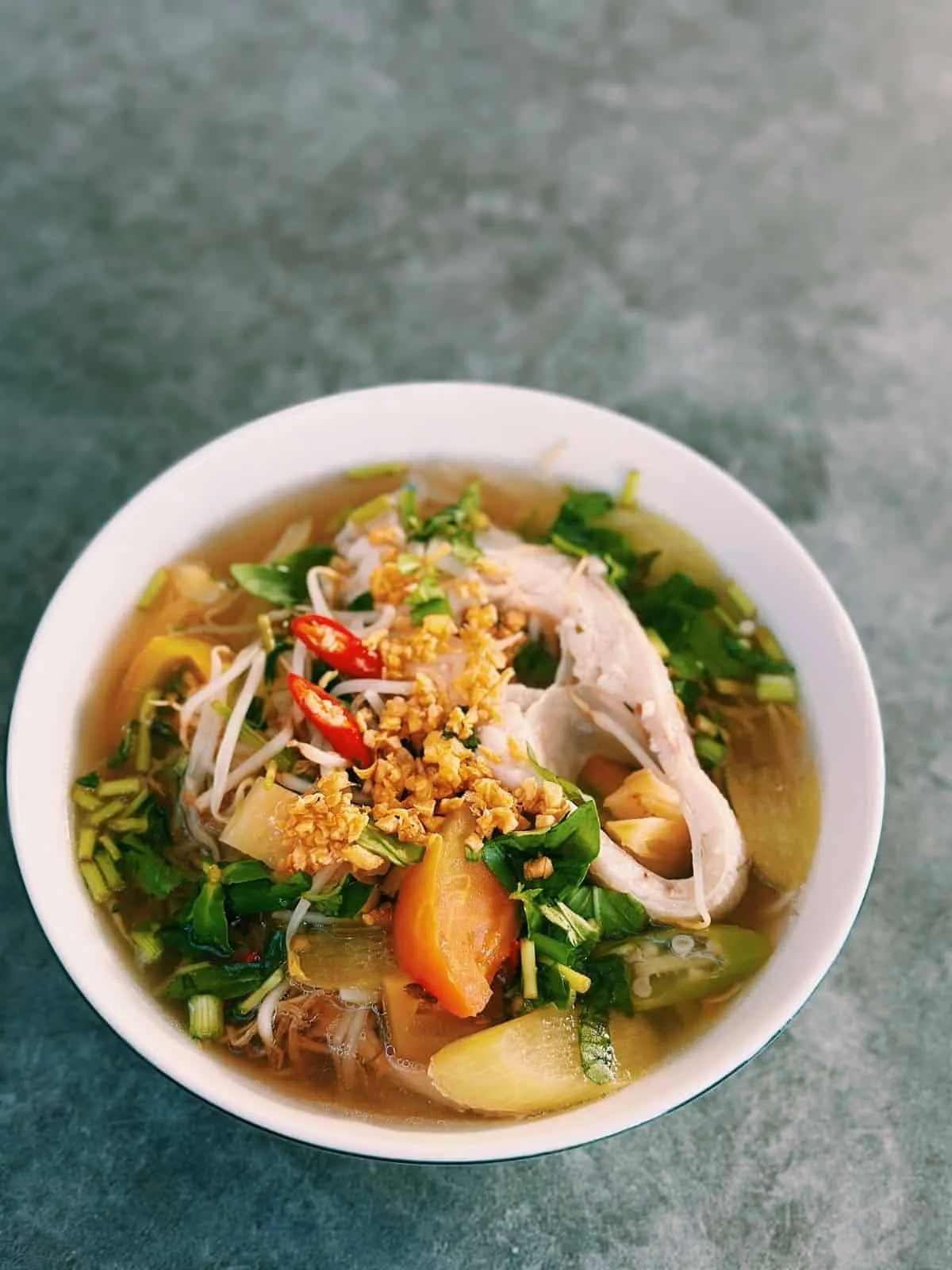
How to Serve Canh Chua
A Delta Classic – In the Mekong Delta, a family meal isn’t complete without a steaming pot of Canh Chua, alongside Ca Kho (caramelized fish) and plenty of jasmine rice. The soup’s sweet-tangy brightness perfectly balances the rich, savory braised fish.
Fish Tips – Traditionally, the fish head and tail flavor the broth, while the meaty steaks are reserved for Cá Kho. At the table, it’s common to lift the cooked fish from the soup and dip it into plain fish sauce with sliced chili—no sugar, no vinegar—just pure, salty goodness.
Serving Style – Ladle the soup and vegetables over jasmine rice for a cozy one-bowl meal, or swap in rice noodles for a lighter version. Either way, it’s comfort food at its very best.
FAQs
Authentic Vietnamese recipes that everyone can cook

Canh Chua (Vietnamese Sweet & Sour Soup)
Ingredients
- 1 pound fish (catfish, salmon, mackerel, tilapia) (fish heads, fillet or steak with bone and skin attached)
- 1 cup pineapple chunks (fresh or canned) (about 1/4 a small pineapple)
- 2 tomatoes (cut into thick wedges)
- 2 oz tamarind paste (55g) (to your taste) (or tamarind concentrate/powder)
- 3 cup beansprouts
- 1 cup shedded banana blossoms (optional)
- 2 elephant ear stalks (peeled, cut diagonally into 1/2-inch or 1 cm pieces)
- 5 okras (optional) (the stem ends trimmed, cut into 1/4-inch or 0.5 cm pieces)
- 1.5 tbsp sugar (to your taste)
- 2 tbsp fish sauce (to your taste)
- ½ tbsp chicken powder (to your taste)
- 5 cup boiling water (1.2 liter)
- Thai chilies (thinly sliced)
- 1 handful rice paddy herbs (ngò om/rau ngổ) (finely chopped) (highly recommend)
- 1 handful sawtooth coriander, lemon basil, Thai basil (finely chopped) (substituted for paddy herbs)
- 1 tbsp fried garlic (or fried shallots) (optional)
Instructions
Make Fried Garlic:
- Fry minced garlic in cooking oil until it turns a light golden brown. Quickly strain it to separate the fried garlic, as the residual heat will continue to cook it. Avoid letting it brown too much to prevent burning.
Prepare the Vegetables:
- Finely chop the herbs and slice the chili.
- Trim the stem ends of the okra and cut it into 1/4 inch (0.5 cm) pieces.
- Peel the elephant ear stems and cut them diagonally into 1/2 inch (1 cm) pieces.
- Cut the tomato into thick wedges and the pineapple into bite-sized chunks. If using canned pineapple, drain and reserve the liquid, then cut the pineapple rings into bite-sized pieces.
Cook the Soup:
- In a pot, pour in boiling water. Add the tomatoes and pineapple (reserving 2-3 wedges of tomato for garnish). Simmer over medium-low heat to allow the fresh flavors to infuse.
- In a heatproof bowl, place the tamarind pulp. Add 2 ladles of boiling water from the pot. Use a spoon to crush the tamarind pulp and dilute it into the water to make a concentrate. Skip this step if using store-bought tamarind concentrate or powder.
- Add 3-4 tbsp of the tamarind liquid back (without seeds) to the pot. Season the soup with fish sauce, chicken powder, sugar, and the juice from the pineapple can (if using). Adjust each ingredient gradually, avoiding adding them all at once. Canh Chua has a flavor profile that is slightly sweeter and less sour than Thai Tom Yum.
- Bring the water back to a boil. Then, add the fish and cook over medium-high heat for about 5 minutes or until the fish is fully cooked.
- Next, add the okra, elephant ear stems, and the reserved tomato. Cook for an additional minute.
- Turn off the heat. Stir in the bean sprouts, shredded banana blossoms (if using), and chopped herbs (reserving some for garnish). Be cautious not to overcook the bean sprouts and herbs. Season the soup once more with fish sauce and sugar if needed.
- Serve the soup in a large bowl, garnishing it with the reserved herbs, sliced chili, and fried garlic.

